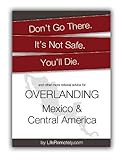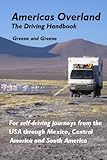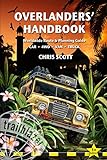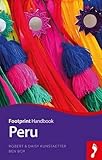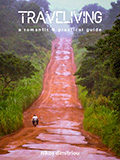Difference between revisions of "Peru"
(→Insurance requirements) |
(→Insurance requirements) |
||
| Line 44: | Line 44: | ||
Insurance is mandatory in Peru, however it's difficult to purchase because the vehicle will not be in the Peruvian computer system. Many people simply show the police SOAT insurance (''Seguro Obligatorio Automóviles Transito'') from another country (i.e. [[Ecuador]] or [[Colombia]]) | Insurance is mandatory in Peru, however it's difficult to purchase because the vehicle will not be in the Peruvian computer system. Many people simply show the police SOAT insurance (''Seguro Obligatorio Automóviles Transito'') from another country (i.e. [[Ecuador]] or [[Colombia]]) | ||
<p> | <p> | ||
| − | Showing SOAT or other 3rd Party Insurance papers from another country is not advisable though. When you get stopped by the police, you'll be in trouble (you might get away with it - as I did - but it's awkward) - they are not | + | Showing SOAT or other 3rd Party Insurance papers from another country is not advisable though. When you get stopped by the police, you'll be in trouble (you might get away with it - as I did - but it's awkward) - they are not stupid and can read Spanish quite well... So they'll easily know if your SOAT is from Peru or from somewhere else. <br />The fine for not having SOAT is about the same amount that you'd pay for one year of insurance, at least for motorbikes. Also, given the fact that Peruvian drivers are probably the craziest in South America (my own experience), you really want to have an insurance. Beyond that, people in Peru cross roads and even motorways without properly watching out for vehicles (also my own experience), and if you hit somebody, you're in even bigger and very serious trouble. |
<br /> | <br /> | ||
After having checked with several Peruvian insurance companies, "La Positiva" was the only one that would give me a shorter insurance period than one entire year: I got 8 months for a motorbike (650cc) for $111 USD in 2013 which I extended by one month (for around $35 USD). Motorbike insurance for a year (as of 2013) would cost from 550 Soles (if you buy it in Lima from "La Positiva") up to 700 Soles (from "Pacifico"). If you buy it in the provinces, you might get it cheaper, but make sure you get an insurance that's valid in the entire country, not just in the given province. | After having checked with several Peruvian insurance companies, "La Positiva" was the only one that would give me a shorter insurance period than one entire year: I got 8 months for a motorbike (650cc) for $111 USD in 2013 which I extended by one month (for around $35 USD). Motorbike insurance for a year (as of 2013) would cost from 550 Soles (if you buy it in Lima from "La Positiva") up to 700 Soles (from "Pacifico"). If you buy it in the provinces, you might get it cheaper, but make sure you get an insurance that's valid in the entire country, not just in the given province. | ||
Revision as of 05:35, 10 September 2013
Currency to display:
Contents
Entering Peru with a Car or Motorbike
Correct as of: January 2012
Required Paperwork
- Passport of registered owner (original and 1 copy).
- Drivers license of registered owner (original and 1 copy).
- Vehicle registration (original and 1 copy).
Process at border
(To check if you need a travel Visa for Peru, application instructions and fees see: Peru Visa online application at VisaHQ.com)
- The owner of the vehicle gains entry at immigration (migración), by getting a tourist card, getting it stamped by the police and finally a stamp in their Passport.
- The owner must show the new passport stamp, drivers license and the original vehicle registration to customs (aduana).
- The owner is issued a temporary import permit for the vehicle.
- If you cross at Tumbes, the kiosk to return your vehicle permit is on the NORTHBOUND side of the highway as you approach the border. It is in a run down, blue and white building in a gravel parking lot about 5kms from the actual border. It looks more like a police check point than an Aduana. If you miss it, Peruvian police will kindly send you back. The Tumbes border was slow, but safe and we saw no corruption.
Cost of entry
Free.
Permitted length of stay
90 days. Cannot be extended from within the country. But you can leave Peru to a neighboring county, spend one night there and then drive your vehicle back to Peru. They'll give you another 90 days: http://www.sunat.gob.pe/orientacionaduanera/internamientovehiculos/index.html (I've done this myself.)
Storing a vehicle and temporarily leaving the country
The temporary import permit can be "suspended" while you leave the country. One person explains their experience as follows:
It's possible to store vehicles in Cusco at La Quinta Camping. The process is as follows, get to the Duana downtown (Cusco) apply for a suspension, the customs and/or Policia Nacional will come to the campground to make sure the vehicle is there. Milagros the manager of the campground will sign a paper that the vehicle will not get moved for the period of time you apply for the importacion temporal being suspended. That's it. You'll fly or bus from Cusco to Lima and off you go. As I understood from them the process took about 48 hours to be completed.
Storage at La Quinta is S/.7.00 PEN for 24 hours.
This is possible anywhere in Peru and works as follows:
1) You enter the country with your vehicle and get an importation permit of 90 days for it.
2) You go to the local "aduana" (SUNAT) and ask for the permission to leave the country without your vehicle. You will need to give them the address of the place where you leave it and probably a declaration of the owner of that place saying that the vehicle will not be (re-)moved (see above).
3) You can then leave the country without it, BUT you will still need to drive it out of Peru before the 90 days of temporary importation expire.
For the legal regulations see http://www.sunat.gob.pe/orientacionaduanera/internamientovehiculos/index.html as well as http://www.sunat.gob.pe/legislacion/procedim/despacho/especiales/vehiculos/procGeneral/inta-pg.16.htm (in Spanish).
Exiting with a vehicle
- The registered owner must get the Police at the border to stamp their tourist card, clearing them to leave Peru.
- The registered owner can then be stamped out of Peru at immigration.
- The registered owner presents the temporary import paper to customs.
Driving in Peru
Insurance requirements
Insurance is mandatory in Peru, however it's difficult to purchase because the vehicle will not be in the Peruvian computer system. Many people simply show the police SOAT insurance (Seguro Obligatorio Automóviles Transito) from another country (i.e. Ecuador or Colombia)
Showing SOAT or other 3rd Party Insurance papers from another country is not advisable though. When you get stopped by the police, you'll be in trouble (you might get away with it - as I did - but it's awkward) - they are not stupid and can read Spanish quite well... So they'll easily know if your SOAT is from Peru or from somewhere else.
The fine for not having SOAT is about the same amount that you'd pay for one year of insurance, at least for motorbikes. Also, given the fact that Peruvian drivers are probably the craziest in South America (my own experience), you really want to have an insurance. Beyond that, people in Peru cross roads and even motorways without properly watching out for vehicles (also my own experience), and if you hit somebody, you're in even bigger and very serious trouble.
After having checked with several Peruvian insurance companies, "La Positiva" was the only one that would give me a shorter insurance period than one entire year: I got 8 months for a motorbike (650cc) for $111 USD in 2013 which I extended by one month (for around $35 USD). Motorbike insurance for a year (as of 2013) would cost from 550 Soles (if you buy it in Lima from "La Positiva") up to 700 Soles (from "Pacifico"). If you buy it in the provinces, you might get it cheaper, but make sure you get an insurance that's valid in the entire country, not just in the given province.
Cost of insurance
$24.00 USD for 3 months for a 4x4.
Where to purchase insurance
If you cross the border from Ecuador at Tumbes, insurance can be purchased in the parking lot of the migracion / aduana.
Driving license
Technically an International Driving Permit is required.
In reality, showing a license from anywhere in the world seems to be good enough.
Driving side of road
Right.
Right hand drive vehicles are permitted without problem.
Mandatory items in vehicle
None.
Roads
General Road quality
Roads in Peru vary greatly. Major highways are often paved and very good quality. Lesser roads are gravel and vary from good to horrendous. If you choose a back-road through the mountains, be prepared for extremely narrow, windy, bumpy, dusty gravel tracks.
Road signs
Road signs do exist, but are far from common. Most towns have at least one sign stating the name of the town and distances to the next towns. Road hazards are often un-signed.
Toll roads
Tolls are very uncommon, and are infrequent when found on some highways. Sometimes only Northbound traffic must pay a toll. When they are uncounted, expect to pay something like USD $2 for at least 100km.
- No tolls are required for motorcycles. For bigger toll stations, keep far right (right of the lorry line-ups) and there will be a small lane to pass.
Bribery in Peru
Police bribery is common in Peru. The Police will try many different tactics to get money from you, including your lack of insurance (they know it's near impossible to buy).
See the bribery tips page for advice.
Checkpoints
Police checkpoints are common in Peru. You will be asked to present your Passport, Vehicle registration, drivers license and the temporary import permit you were issued at the border.
Traveling with pets
Unknown.
List the entry requirements and anything else required to travel with a pet.
Gas and Diesel price in Peru
Last updated: August 2013
Currency and unit to display:
| Gasoline Grade | Price |
|---|---|
| Regular (84) | $4.96 USD per Gallon (US) |
| Super (90) | $5.57 USD per Gallon (US) |
| Premium (95) (rare) | ?? |
| Ultra (97) (rare) | ?? |
| Normal Diesel | $5.68 USD per Gallon (US) |
| Diesel (low sulfur) | ?? |
- Price Information: gasoline-germany.com - International Gas / Petrol / Diesel prices - Peru
Gas and Diesel / Frequency
Purchasing gas in Peru is not commonly a problem.
Typically gas stations are not more than 200 - 300km apart.
Gas and Diesel Quality
Gasoline purchaed from name-brand outlets (ie. PetroPeru, Repsol) is regarded as better quality than a "no name" mechanic (grifo).
Safety and Security Considerations
Driving at night
Driving at night is generally not recommended, though might be OK on the larger highways.
- Poor road quality means potholes and obstacles are common.
- Dangerous driving such as tailgating, overtaking around blind corners and excessive speeding are very, very common.
- There can be many objects on and around the road that are nearly impossible to see at night, such as livestock, people, slow moving carts, cars with no lights, etc.
Vehicle parking
Parking vehicles on the street in smaller towns during the day is typically OK. Find a secure parking lot in big cities and at night.
Special driving considerations
Drivers in Peru are particularly crazy, which leads to some very dangerous driving conditions. There have been many horrific accidents in recent years (some involving Overlanders) due to large trucks and buses taking hairpin corners in the wrong lane. Sound your horn loudly when approaching any sharp corners on mountainous roads.
Don't be afraid to give a couple of short taps on your horn in heavy traffic, it's not impolite, and lets other drivers know where you are.
Security advisories and information
- Country Specific Information - U.S. Department of State
- Travel Reports and Warnings - Foreign Affairs and International Trade Canada
- Travel advice by country - Foreign and Commonwealth office (U.K.)
- Travel Advice for Peru - Australian Department of Foreign Affairs and Trade
Camping in Peru
Camping is not common or popular with local Peruvians, though many hostels in touristy areas have camping to cater for backpackers.
Prices for camping at hostels fluctuates with the tourist seasons - check a backpacker guide book.
There are many excellent sites for roadside camping around the Cordillera Blanca in central Peru.
Camping guide books
No specific book exists, though the usual backpacker guide books mention when a hostel or park has camping facilities.
Drinking water
Tap water in Peru is not safe to drink. Every corner store sells 1 and 2 liter bottles, and 20 liter bottles can be bought at most large grocery stores.
Paper maps
Maps of Peru are difficult to find, and road conditions change daily. Purchase maps before arriving in Peru.
GPS Maps of Peru
- Perut (Peru Routeable): A community map project like OSM with excellent coverage for Garmin[1]
- Open Street Map: Appears to have good coverage.[2]
- Garmin: No map of Peru.[3]
- TomTom: No map of Peru. [4]
GPS co-ordinates for camping, propane, gas, repairs, etc. in Peru
- Camping Sites: Peru - Detailed list of campsites and propane filling with description, directions and GPS co-ordinates. Some at hotels (lists facilities and price), some roadside and free.
- Campsite Listing - South America | PanAm Notes - List of campsites, with directions and GPS co-ordinates. Some at hotels (lists facilities and price), some roadside and free.
- Andes Expedition camping Locations - List of campsites, with basic directions and GPS co-ordinates. Mostly free sites.
- Camping Log 2: South America - List of campsites, shopping, fuel, propane and border crossings with excellent descriptions and GPS co-ordinates.
- Hackney Travel SA Waypoints - Raw GPS data (in gdb or gpx format) for waypoints (including campsites, fuel, repairs, propane and more)
- The Silk Road Motocaravan Network - Raw GPS data for waypoints (camping, gas, propane, points of interest and more)
Special Overland Travel interests
- Machu Picchu - It's not possible to drive all the way to Machu Picchu, but you can get pretty close and save yourself a lot of money by not catching the train. From the Cuzco area, drive through The Sacred Valley, passing Pisac, Ollantaytambo, Santa Maria and finally along a very narrow little track to the village of Santa Teresa. The last section of road is very narrow and windy, and requires a high-clearance vehicle. In Santa Teresa you can camp and safely leave your vehicle at the Inka Tour Hospedaje - the only campground in town. From Santa Teresa you can hike four hours, or catch a taxi to Hydroelectrica, where you can hike along the tracks or catch the train to Aguas Calientes which is the town at the base of Matchu Pitchu. Don't drive to Hydroelectrica - it's only a construction site and there is absolutely nowhere to park (even for motorbikes)[5].
- Camping at La Quinta Camping in Cusco - A favorite of many Overlanders, this is a fantastic place to meet others, and unwind while being close to the city center with wifi, hot showers, etc.
Travel Guide Books
Vehicle Maintenance
Dealers
4x4s / Trucks
- Toyota Global Dealer Locator
- Land Rover International Dealer Locator
- Mercedes Benz International (select country on bottom right)
- Jeep International site locator
Motorbikes
Local Garages
Add known good mechanics here.
Buy or sell a car or motorbike in Peru
Buy
A foreigner can buy and register a Peruvian vehicle and drive it outside Peru. An export fee of Error in price tag: The cost attribute must be specified." will be charged to any foreigner removing a Peru registered vehicle from the country.
Sell
Unknown.
Describe how a foreigner can sell a foreign-plated vehicle, or list not possible.'
References
- ↑ Peru Routeable (In Spanish)
- ↑ OpenStreetMap Peru
- ↑ Garmin coverage map
- ↑ TomTom Map availability
- ↑ Machu Picchu - The Road Chose Me
Helpful External links
- Peru: Visa and Passport requirements | World Travel Guide
- Health Information for Travelers to Peru - Center for Disease Control and Prevention
- Peru travel guides at wikivoyage
- Peru - Wikipedia, the free encyclopedia


